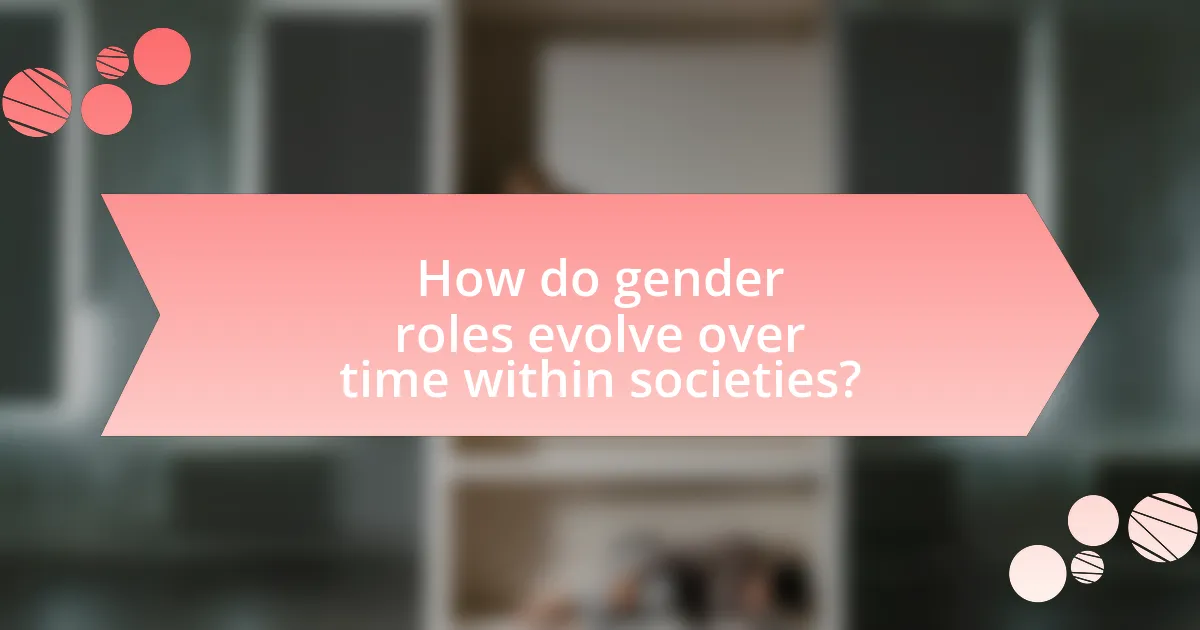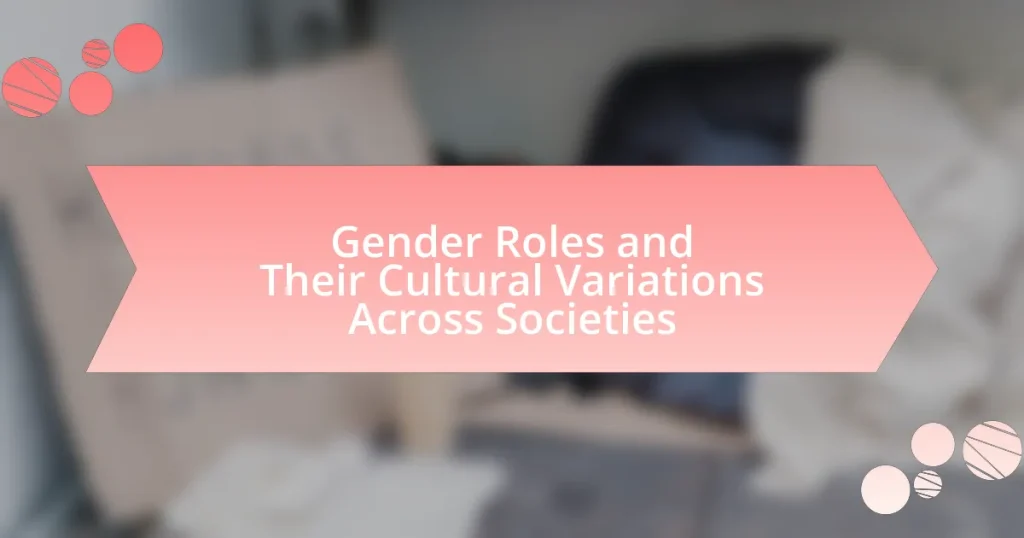Gender roles are societal norms that dictate behaviors and expectations based on gender, varying significantly across cultures. This article explores the cultural variations of gender roles, examining how they manifest in different societies, their historical influences, and the impact of social norms, religion, and economic development. It highlights the importance of understanding gender roles in shaping cultural identity and societal structure, as well as the challenges faced in changing traditional roles. Additionally, the article discusses strategies for promoting gender equality and the role of social movements in redefining these norms.

What are Gender Roles and Their Cultural Variations Across Societies?
Gender roles are societal norms dictating the behaviors, activities, and expectations considered appropriate for individuals based on their gender. These roles vary significantly across cultures; for instance, in many Western societies, traditional gender roles often emphasize male dominance in leadership and female nurturing roles, while in some Indigenous cultures, gender roles may be more fluid, allowing for a spectrum of identities and responsibilities. Research by Eagly and Wood (1999) in “The Origins of Sex Differences in Human Behavior” highlights how these roles are shaped by both biological and social factors, demonstrating that cultural context plays a crucial role in defining and enforcing gender expectations.
How do gender roles manifest in different cultures?
Gender roles manifest in different cultures through distinct expectations and behaviors assigned to individuals based on their gender. For instance, in many Western cultures, traditional gender roles often emphasize male dominance in professional settings and female nurturing roles in domestic spheres. Conversely, in some Indigenous cultures, gender roles may be more fluid, allowing individuals to take on responsibilities irrespective of gender, as seen in the Two-Spirit identity among Native American tribes, which recognizes a blend of masculine and feminine traits. Additionally, research indicates that in Scandinavian countries, gender roles are more egalitarian, with policies promoting shared parental leave and equal participation in the workforce, resulting in higher gender equality indices. These cultural variations illustrate how societal norms shape the understanding and enactment of gender roles across different contexts.
What are the historical influences on gender roles in various societies?
Historical influences on gender roles in various societies stem from cultural, economic, and religious factors. For instance, in agrarian societies, labor division based on physical strength often led to men taking on roles as primary providers, while women were relegated to domestic responsibilities. This division was reinforced by religious doctrines, such as those found in many ancient texts, which prescribed specific roles for men and women. In contrast, during the Industrial Revolution, the shift to factory work began to alter these roles, as women entered the workforce in greater numbers, challenging traditional norms. Additionally, movements for women’s rights in the 19th and 20th centuries, such as suffrage and feminist movements, further transformed gender roles by advocating for equality and expanding women’s participation in public life. These historical contexts illustrate how gender roles have been shaped and reshaped over time by various societal influences.
How do social norms shape gender roles in different cultures?
Social norms significantly shape gender roles in different cultures by establishing expectations for behavior, responsibilities, and identities based on gender. For instance, in many Western cultures, traditional norms often dictate that men should be the primary breadwinners while women are expected to take on caregiving roles. This is evidenced by historical data showing that, as of 2020, women in the U.S. earned approximately 82 cents for every dollar earned by men, reflecting entrenched societal expectations regarding gender roles in the workforce. Conversely, in some Indigenous cultures, gender roles may be more fluid, allowing for a broader range of expressions and responsibilities, as seen in the recognition of Two-Spirit individuals who embody both masculine and feminine traits. These cultural variations illustrate how social norms dictate the roles individuals are expected to fulfill, influencing everything from family dynamics to professional opportunities.
Why are gender roles important in understanding cultural identity?
Gender roles are crucial in understanding cultural identity because they shape individual behaviors, societal expectations, and community norms. These roles dictate how individuals interact within their culture, influencing everything from family dynamics to professional opportunities. For instance, in many societies, traditional gender roles assign caregiving responsibilities primarily to women, which can affect women’s access to education and employment. This dynamic is evident in research by Eagly and Wood (1999), which highlights how gender roles are socially constructed and vary across cultures, impacting the overall cultural identity of a society. Understanding these roles allows for a deeper comprehension of cultural values and social structures, revealing how identity is formed and expressed within different contexts.
How do gender roles contribute to societal structure and function?
Gender roles significantly shape societal structure and function by establishing expectations for behavior, responsibilities, and power dynamics between genders. These roles influence various aspects of life, including family organization, workforce participation, and political representation. For instance, traditional gender roles often assign caregiving and domestic responsibilities primarily to women, which can limit their economic opportunities and reinforce gender inequality. According to the World Economic Forum’s Global Gender Gap Report 2021, countries with rigid gender roles tend to exhibit larger gender gaps in economic participation and political empowerment, demonstrating how these roles can hinder societal progress and equality.
What role do gender roles play in individual identity formation?
Gender roles significantly influence individual identity formation by shaping expectations, behaviors, and self-perception based on societal norms associated with masculinity and femininity. These roles dictate how individuals are expected to act, think, and feel, often leading to internalized beliefs about their capabilities and worth. Research indicates that children learn gender roles through socialization processes, such as family dynamics and media representation, which can reinforce stereotypes and limit personal expression. For example, a study by Eagly and Wood (1999) in the “Psychological Bulletin” highlights how traditional gender roles can restrict individuals’ choices and opportunities, ultimately affecting their identity development.

What are the key factors influencing gender roles across cultures?
Key factors influencing gender roles across cultures include socialization, economic structures, religious beliefs, and legal frameworks. Socialization processes, such as family upbringing and educational systems, shape individuals’ perceptions of gender expectations from a young age. Economic structures, including labor division and access to resources, dictate the roles men and women play in society; for instance, in agrarian societies, physical labor often defines gender roles, while in industrialized nations, professional roles may vary. Religious beliefs significantly impact gender norms, as many religions prescribe specific roles for men and women, influencing societal expectations. Legal frameworks, such as laws regarding gender equality and women’s rights, also play a crucial role in shaping gender dynamics; countries with strong legal protections for gender equality tend to exhibit more equitable gender roles. These factors collectively contribute to the diverse expressions of gender roles observed across different cultures.
How do religion and spirituality affect gender roles?
Religion and spirituality significantly influence gender roles by establishing norms and expectations regarding behavior, responsibilities, and social status for different genders. For instance, many religious traditions prescribe specific roles for men and women, often positioning men as leaders and providers while women are seen as caregivers and homemakers. This is evident in Christianity, where traditional interpretations of scripture often emphasize male authority, and in Islam, where gender roles are defined by religious texts that outline distinct responsibilities for men and women. Studies, such as those conducted by sociologist Lisa McIntosh Sundstrom, demonstrate that these religious frameworks can reinforce patriarchal structures, impacting women’s rights and opportunities in various societies. Thus, the interplay between religion, spirituality, and gender roles shapes societal expectations and individual identities across cultures.
What are the specific religious teachings that shape gender expectations?
Specific religious teachings that shape gender expectations include the interpretation of sacred texts, doctrines, and cultural practices within various faiths. For instance, in Christianity, traditional interpretations of the Bible often emphasize male leadership in both the church and the family, as seen in passages like Ephesians 5:22-24, which discusses the roles of husbands and wives. In Islam, teachings from the Quran and Hadith outline distinct roles for men and women, with men often viewed as providers and women as caretakers, as reflected in Surah An-Nisa 34. Hinduism also presents gender expectations through texts like the Manusmriti, which delineates duties and roles based on gender, often placing women in subordinate positions. These teachings collectively influence societal norms and expectations regarding gender roles across different cultures.
How do religious practices reinforce or challenge traditional gender roles?
Religious practices can both reinforce and challenge traditional gender roles depending on the specific beliefs and interpretations within each faith. For instance, many conservative interpretations of Christianity and Islam often uphold traditional gender roles, emphasizing male leadership and female submission, as seen in scriptural texts that prescribe distinct roles for men and women. Conversely, some progressive religious movements, such as certain branches of Judaism and Christianity, actively challenge these norms by promoting gender equality and female leadership within religious contexts, as evidenced by the ordination of women in various denominations. This duality illustrates how religious practices can serve as a mechanism for both the preservation and transformation of gender roles in society.
What impact does economic development have on gender roles?
Economic development significantly alters gender roles by promoting gender equality and increasing women’s participation in the workforce. As economies grow, women gain access to education and employment opportunities, which challenges traditional gender norms. For instance, research from the World Bank indicates that countries with higher economic development exhibit lower gender disparities in labor force participation, with women increasingly taking on roles in various sectors, including leadership positions. This shift not only empowers women but also contributes to overall economic growth, as diverse workforces enhance productivity and innovation.
How does access to education influence gender role perceptions?
Access to education significantly influences gender role perceptions by promoting equality and challenging traditional stereotypes. When individuals, regardless of gender, receive education, they gain knowledge and skills that empower them to pursue diverse career paths and roles in society. Research indicates that higher levels of education correlate with more progressive views on gender roles, as educated individuals are more likely to support gender equality and reject discriminatory practices. For instance, a study by the World Bank found that educated women are more likely to participate in the labor force and make decisions regarding their own lives, thereby reshaping societal expectations around gender. This shift in perception fosters an environment where both men and women can engage in roles that were traditionally assigned based on gender, leading to a more equitable society.
What is the relationship between employment opportunities and gender roles?
The relationship between employment opportunities and gender roles is significant, as traditional gender roles often dictate the types of jobs deemed appropriate for men and women. Societal expectations can limit women’s access to certain professions, leading to gender disparities in employment. For instance, data from the World Economic Forum’s Global Gender Gap Report indicates that women are underrepresented in leadership positions and high-paying industries, which reflects entrenched gender norms. Additionally, research by the McKinsey Global Institute shows that closing gender gaps in labor force participation could add $28 trillion to global GDP by 2025, highlighting the economic impact of addressing these disparities. Thus, gender roles directly influence the availability and accessibility of employment opportunities for different genders.

How do gender roles evolve over time within societies?
Gender roles evolve over time within societies through a combination of cultural, economic, and political changes. Historical shifts, such as the industrial revolution, transformed labor dynamics, leading to increased participation of women in the workforce, which challenged traditional gender norms. For instance, during World War II, women took on roles traditionally held by men, demonstrating their capability in various sectors, which contributed to the gradual acceptance of gender equality. Additionally, movements advocating for women’s rights, such as the suffrage movement in the early 20th century, have significantly influenced societal perceptions of gender roles, promoting the idea that both genders should have equal opportunities and responsibilities. These changes are often reflected in legislation, educational access, and media representation, further reinforcing the evolution of gender roles over time.
What are the effects of globalization on gender roles?
Globalization significantly alters gender roles by promoting greater gender equality and challenging traditional norms. As economies become interconnected, women gain increased access to education and employment opportunities, which empowers them and shifts societal expectations. For instance, the World Bank reported that countries with higher levels of globalization tend to have lower gender gaps in labor force participation. Additionally, exposure to diverse cultures through media and communication fosters progressive attitudes towards gender roles, leading to a reevaluation of women’s positions in both public and private spheres. This transformation is evident in various regions, where women are increasingly participating in leadership roles and decision-making processes, reflecting a broader societal shift towards gender equity.
How do media representations influence changing gender roles?
Media representations significantly influence changing gender roles by shaping societal perceptions and expectations of gender behavior. For instance, television shows and films that depict women in leadership roles or men as caregivers challenge traditional stereotypes, promoting a more equitable view of gender capabilities. Research by the Geena Davis Institute on Gender in Media indicates that increased representation of women in media correlates with shifts in public attitudes towards gender equality, as audiences begin to see diverse roles as normative rather than exceptional. This demonstrates that media not only reflects but actively constructs and transforms gender norms within society.
What role do social movements play in redefining gender roles?
Social movements play a crucial role in redefining gender roles by challenging traditional norms and advocating for equality and inclusivity. These movements, such as feminism and rights, actively confront societal expectations and promote new understandings of gender identity and expression. For instance, the feminist movement has historically fought for women’s rights, leading to significant changes in laws and social perceptions regarding women’s roles in both public and private spheres. Research indicates that in the 20th century, the women’s liberation movement contributed to increased participation of women in the workforce, which altered traditional gender roles significantly. Additionally, movements have expanded the conversation around gender, introducing concepts like gender fluidity and non-binary identities, further reshaping societal norms. Thus, social movements not only advocate for change but also create a cultural shift that redefines how gender is perceived and enacted in society.
What are the challenges faced in changing traditional gender roles?
Changing traditional gender roles faces significant challenges, primarily rooted in deeply ingrained cultural norms and societal expectations. These norms often dictate behaviors and responsibilities based on gender, making it difficult for individuals to deviate from established roles without facing social backlash. For instance, research by the World Economic Forum indicates that gender stereotypes persist globally, with 75% of men and women believing that men should be the primary breadwinners. This belief reinforces economic disparities and limits opportunities for women in the workforce. Additionally, resistance from both men and women to redefine roles can lead to conflict within families and communities, further complicating efforts for change.
How do resistance and backlash manifest against evolving gender roles?
Resistance and backlash against evolving gender roles manifest through social movements, legislative actions, and cultural narratives that seek to maintain traditional gender norms. For instance, in various societies, there has been a rise in conservative movements that advocate for the preservation of conventional roles, often citing religious or cultural beliefs as justification. Additionally, backlash can be observed in the form of policies that restrict gender equality initiatives, such as laws limiting reproductive rights or opposing same-sex marriage, which reflect a desire to revert to established gender hierarchies. Research indicates that these reactions are often fueled by fears of losing social status or economic power, as seen in studies that link economic downturns to increased resistance against gender equality efforts.
What strategies can be employed to promote gender equality in various cultures?
Strategies to promote gender equality in various cultures include education, policy reform, and community engagement. Education initiatives that focus on gender sensitivity can change perceptions from a young age, as studies show that educated individuals are more likely to support gender equality. Policy reforms, such as implementing equal pay legislation and parental leave policies, have been effective in countries like Sweden, where gender equality is prioritized in the workforce. Community engagement through grassroots movements can empower local voices, as seen in initiatives like the HeForShe campaign, which encourages men to advocate for women’s rights. These strategies collectively contribute to a more equitable society by addressing cultural norms and systemic barriers.
What practical steps can individuals take to challenge traditional gender roles?
Individuals can challenge traditional gender roles by actively promoting gender equality in their daily lives. This can be achieved through several practical steps: first, individuals should educate themselves and others about gender stereotypes and their impacts, fostering awareness of biases. Second, they can support and participate in initiatives that advocate for equal opportunities in workplaces and educational settings, such as mentorship programs for underrepresented genders in various fields. Third, individuals can model non-traditional behaviors by sharing household responsibilities equitably, thereby demonstrating that tasks are not inherently gendered. Lastly, engaging in open conversations about gender roles within families and communities can help dismantle preconceived notions and encourage more inclusive perspectives. These actions collectively contribute to a cultural shift towards greater gender equality.
